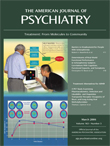Psychosis Related to Ropinirole
To the Editor:
The dopamine receptor agonist ropinirole, an effective initial therapy for mild to moderate Parkinson’s disease, has also been recently indicated for the treatment of restless legs syndrome. Ropinirole has a high affinity for all dopamine D2 subfamily receptors and shows highest affinity for the D3 receptor subtype (1). Studies have suggested it has antidepressant qualities in Parkinson’s disease and treatment-resistant depression, and at least two cases of mania have been documented (2, 3). To our knowledge, there have been no reports of cases of psychosis related to the use of ropinirole until now.
Ms. A was a 44-year-old woman with a family history of schizophrenia and a 1-year history of depression who was admitted to the hospital with acute psychotic symptoms, including paranoid delusions, disorganized thoughts, and auditory and visual hallucinations. Her affect was blunted. She had been given a prescription for ropinirole 1 week before admission for restless legs syndrome. Upon admission, the ropinirole was discontinued. Quetiapine and citalopram were prescribed. Within 3 days, Ms. A’s paranoia had improved. Her thought process had become more organized and logical, and her affect had brightened. Her sleep ranged from 7 to 9 hours throughout the hospitalization. She improved steadily each day until her discharge 6 days after admission.
In clinical trials, the dopamine agonist ropinirole has produced hallucinations and confusion rated as mild (4). We provide evidence here that ropinirole may induce or exacerbate severe, acute psychosis in a patient without Parkinson’s disease. This case is not conclusive in part because of the use of quetiapine. However, the rapidity and degree of improvement weigh in favor of a strong role for ropinirole, and the likelihood of such an effect with this medication stands to reason. Given the recognized relationship of dopaminergic function to psychosis, best known through the strong antipsychotic effects of dopamine antagonists, such an effect of exacerbating psychosis by a dopamine agonist seems almost predictable. We suggest that ropinirole, like all other dopaminergic agents, be used with caution in psychotic patients and those vulnerable to psychosis.
1. Willner P: The mesolimbic dopamine system as a target for rapid antidepressant action. Int Clin Psychopharmacol 1997; 12(3 suppl):S7-S14Google Scholar
2. Singh A, Althoff R, Martineau RJ, Jacobson J: Pramipexole, ropinirole, and mania in Parkinson’s disease (letter). Am J Psychiatry 2005; 162:814–815Link, Google Scholar
3. Cassano P, Lattanzi L, Fava M, Navari S, Battistini G, Abelli M, Cassano GB: Ropinirole in treatment-resistant depression: a 16-week pilot study. Can J Psychiatry 2005; 50:357–360Crossref, Medline, Google Scholar
4. Schrag AE, Brooks DJ, Brunt E, Fuell D, Korczyn A, Poewe W, Quinn NP, Rascol O, Stocchi F: The safety of ropinirole, a selective nonergoline dopamine agonist, in patients with Parkinson’s disease. Clin Neuropharmacol 1998; 21:169–175Medline, Google Scholar



